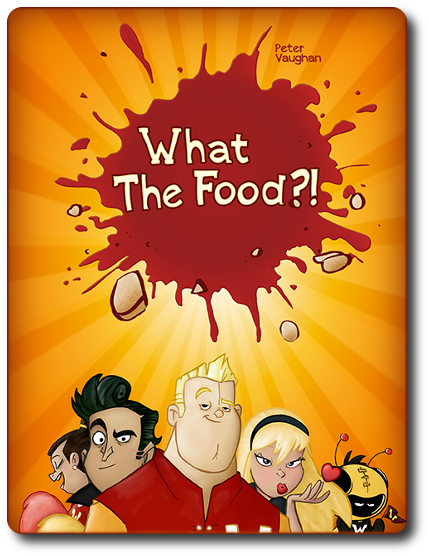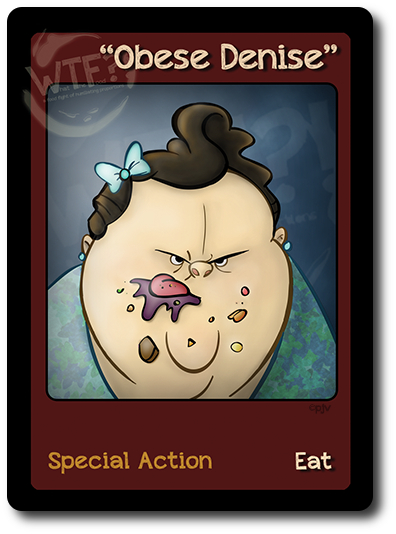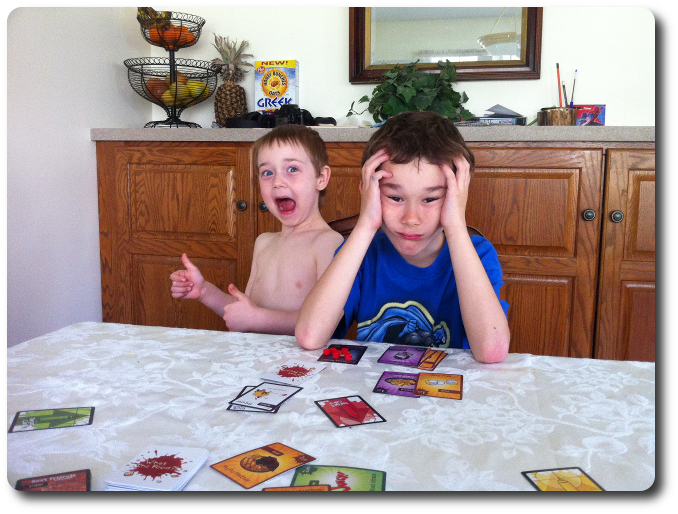Please Take Note: This is a review of the game’s final prototype. The art, game bits, and the rules discussed are all subject to change. The game is being reviewed on the components and the rules provided with the understanding that “what you see is not what you might get” when the game is published. If you like what you read and want to learn more, we encourage you to visit the game’s Kickstarter campaign. Now that we have all that disclaimer junk out of the way, on with the review!

The Basics:
- For ages 8 and up
- For 2 to 8 players
- Approximately less than 30 minutes to complete
Geek Skills:
- Active Listening & Communication
- Counting & Math
- Logical & Critical Decision Making
- Reading
- Emotional Coping Skills
- Pattern/Color Matching
- Hand/Resource Management
Learning Curve:
- Child – Easy
- Adult – Easy
Theme & Narrative:
- Prepare for an epic food fight of epicness
Endorsements:
- Gamer Geeks rejected!
- Parent Geeks approved!
- Child Geeks mixed!
Overview
It started out like any other day in the lunchroom. The popular kids sat on one side and everyone else squeezed in on the other. Some say it all started when a brave tuba player from the Pep Band chucked his fruit cup at the football team’s quarterback. Some say it was the disgruntled lunch lady. The only thing known for certain is that everyone in that lunchroom came out wearing their lunch that day.
What the Food?!, designed by Peter Vaughan, will reportedly be comprised of 8 Character cards (one per player), 8 Starting Action cards, 8 Condiment Targeting cards, 32 Special Action cards, 8 additional Action cards, 36 Food cards, 9 Toppings cards, 9 Condition cards, 9 Event cards, an assortment of Humiliation cubes, and 1 Starting Player card. Actually, we don’t have much confident in what we just stated as there are reportedly 14 characters that might be included, more Event cards that might be added, and a few of the rules are still being tweaked. Like the title of the review states, this is a review of a prepublished game and nothing is for certain until the game is published. What we do know for certain is that the games’ illustrations are exceedingly well done, comical, and fit the game’s theme perfectly.
Walking to the Cafeteria
To set up the game, first shuffle the Character cards and deal 1 to each player randomly. The Character cards identify which character the player is representing. Character cards are always kept face-up and in front of the player. If it helps, consider it a big target, but they also serve as reminders to the players regarding special character actions. Any unused Character cards are removed for the duration of the game.

Second, randomly deal out to each player a Condiment Targeting card, making sure the “Relish” Condiment Target card is included. These are placed in front of their owning player for now. Feel free to point them to other players even though the game hasn’t started yet. It never hurts to play little mind games with your opposition. Any unused Condiment Targeting cards are removed for the duration of the game.

Third, look through the deck and remove any card with a “Flag” on the top of it. These cards are the Starting Action cards. Each player will receive a “Pick Choice”, “Throw”, and “Duck” Starting Action card. In addition, they will also receive one character-specific Starting Action card. These cards are unique to the player’s character and have an illustration on them that depicts the character on the player’s Character card. In total, each player should now have 4 Starting Action cards. All the remaining Starting Action cards with a “Flag” on them are removed for the duration of the game.

Fourth, shuffle together the Food, Toppings, Conditions, Event, and Non-Starting Action cards into one deck. This is the draw deck for the duration of the game. Place the draw deck face-down on the table and draw the top 3 cards. These are placed to the side of the draw deck, face-up, to create “The Trash” (discard pile). Then take the top 5 cards from the draw deck and place them, face-up, in the middle of the playing area which is now referred to as “The Floor”. If any Event cards are draw, discard it to the discard pile and draw another card. Finally, deal 2 cards from the draw deck to each player who adds them to their hand for a total of 6 cards. Again, if any Event cards are drawn, discard it to discard pile and draw another card.
Fifth, take the Humiliation point cubes and set them in a pile off to one side of the game playing area.
Sixth, the player who was dealt the “Relish” Condiment Targeting card is the first player. Starting with the first player, each player will now point their Condiment Targeting card at a player of their choice on the count of 3.
That’s it for game set up! Let’s go get lunch!
Time for Lunch (Fight)
The game is played in rounds with each round being comprised of a number of steps (referred to as “turns” in the rule book). A typical round is summarized here.
Step 1: Rotate Starting Player
The first step of every round is to move the “Relish” Condiment Targeting card to the next player going clockwise. Of course, this means that all the other Condiment Targeting cards move, too. Note that this step is skipped during the first round of the game.
Step 2: Change Targets or Don’t
The second step of every round allows the players to change who they are targeting. This is optional and a player is never forced to change their target. To change a target, the player need only point their Condiment Targeting cards to any player of their choice. Note that this step is skipped during the first round of the game.
Step 3: Choose Action
The third step of every turn gets the players thinking. Out of their hand of cards, the players need to select 3 Action cards and place them face-down in front of them in a stack. The top card of the stack will be the player’s first action, the middle card will be the player’s second action, and the bottom card will be the player’s third action. The basic actions are summarized here.
- Throw: this action allows the player to throw food at their target.
- Pick Choice: this action allows the player to quickly run out onto The Floor and pick one card (or two Food cards) of their choice that are currently available. Once the card or cards are picked up, it is immediately added to the player’s hand and a new card is drawn from the deck replacing the cards just taken.
- Duck: this action allows the player to avoid “Throw” actions, but does not make the player entirely safe.
Step 4: Perform Actions & Take Humiliation
The fourth step is all about the food fight! Every player now flips over their first action and follows the instructions listed on the card in turn order sequence, starting with the first player. Play continues clockwise. There are a number of cards the player will be using to resolve their actions. They are summarized here.
- Food (orange): these are the most basic of armaments and deal out Humiliation points.
- Toppings (purple): these are upgrades and just one more layer of muck to add to your opponent’s face. Like Food cards, they add Humiliation points.
- Conditions (green): these cards describe the condition of the food and toppings being tossed, add Humiliation points, but can only be used when paired with Food and Toppings.
- Actions: these cards are added to the player’s “bag of tricks” and are used in the same way as the player’s Starting Action cards in step 3. These cards are never discarded, cannot be traded, or in any way lost. All actions that force a player to discard, pass, or trade a card only affect Food, Toppings, and Condition cards.
- Events: these cards are game changers. When they are drawn from The Floor or the draw deck, they are immediately resolved and then discarded.

After each player has flipped over and resolved their first action, any cards that cause Humiliation points to the player’s target are now resolved. For every Humiliation point “earned”, one Humiliation point cube is given to the targeted player. Humiliation points are kept out in front of the player and visible to all. In an abstract way, this represents how much food the player has dripping off them.
Through clever card play and skillful hand management, players can create “combos” that are played during a single action.
- 1 Food or 1 Topping card = 1 Humiliation point
- 1 Food + 1 Topping card = 2 Humiliation points
- 2 Toppings cards = 2 Humiliation points
- 1 Food + 1 Condition card = 3 Humiliation points
- 1 Topping + 1 Condition card = 3 Humiliation points
- 1 Food + 1 Topping + 1 Condition card = 4 Humiliation points and the player gets to reduce their total number of Humiliation points by 2
- 1 Condition + 2 Toppings = 4 Humiliation points and the player gets to reduce their total number of Humiliation points by 2
Repeat the above for the second and third actions. All cards played (exception action cards) are always placed in the discard pile
Step 5: Check for End of Game or Next Round
The fifth step is a quick check to see if the game has come to an end. If any player has 10 or more Humiliation points, the game immediately comes to a close (see “Endgame”). If not, a new round begins.
Endgame
If any player has 10 or more Humiliation points at the end of the round, the game (and food fight) come to a screeching halt as the Principle bursts in and screams, “WHAT IN THE *&$@!^&$ DO YOU THINK YOU ARE DOING?!?!?!” Everyone involved will get detention, but the player who has the least amount of Humiliation points is the winner of the game and will be a legend in the school hallways for years to come.
Game Variants
- All Character Starting Action Cards: During the game set up, any Starting Action cards that match Character cards not selected are removed. This game variant allows them to remain and they are shuffled into the deck along with the Food, Toppings, Conditions, Event, and Non-Starting Action cards.
To learn more about What the Food?!, visit the game’s Kickstarter campaign.
Prediction
I’ve been told this game is like Bang!, but I think it closer resembles Ca$h ‘n Gun$. In Bang!, players take on specific roles, like What the Food?!, but these roles in Bang! define a player’s victory condition. This is not the case for What the Food?! and why I think it is closer to Ca$h ‘n Gun$ where the object of the game is to simply out last the other players. Why do I bother to mention this? Simply put, I have a concern…
What the Food?! is not a “friendly” game. Everyone is out to get everyone else. For young adults and adults, this type of game play is chaotic and fun. For Child Geeks, games like this can be an emotional rollercoaster. I should make it clear that I and none of the players we will be playing this game with have any philosophical, political, or theological abhorrence to such games – just the opposite in fact – but games of this type of play do tend to make our children rather “put out”.
As such, I predict mixed results from the Child Geeks. I think their level of endorsement for What the Food?! is going to hinge on how much they personally feel beat up by it. For the Parent Geeks, I think they are going to enjoy it. For the Gamer Geeks, I think they might find it amusing for a few turns and then start to get tired of it. Of course, we simply don’t know until we try, so let’s get to teaching the game!
The game has been designed so all you really need to do is read the cards when they get in your hand to understand what you can and cannot do with them. Other than that, we took just a few minutes to explain how the game was played, a typical round of play, and how food was chucked or ducked. All the players understood the game pretty much from the start with only a few questions regarding card combos. After we got those out-of-the-way, everyone was ready to play.
And so, as I had my 8-year-old shuffle the deck of cards for our first game, I asked him his thoughts on What the Food?! so far.
“A game about fighting with food? You know I’m going to like it!” ~ Liam (age 8)
Very happy to hear he is excited to play! Lets see if his level of enthusiasm remains after he has food on his face.
Final Word
The Child Geeks flip-flopped on this one and their level of approval was highly dependent on how the game played out. If they were winning or not being targeted (or feeling targeted) much, they highly approved of What the Food?! If they were feeling picked on or just couldn’t work out how to avoid being hit, they hated the game. Hated it with a passion. This is a game that will test the emotional coping skills of just about any player. There is nothing stopping a group from singling out a player and smacking them like crazy again and again. When the Child Geeks were on the giving end of that pointy stick, they were laughing and have a great time. When they were on the receiving end, not so much. As a result, the approval rating for What’s the Food?! was mixed. Lots of emotional ups and downs, some freakouts, and one very close flipping of the table moment.

My 8-year-old sinks deeper into dismay whenever he is targeted, while his younger brother is ecstatic
The Parent Geeks were much more cool about the game. They really enjoyed What’s the Food?! and thought it was a fun and quick family and party game. They rolled their eyes at their Child Geeks when they pouted and reminded them it was “just a game”. Even after being hit….a lot…by their Child Geeks, the Parent Geeks thought the game was still a good time. They voted to approve it. According to one Parent Geek, “I like it. Good artwork, easy rules, and fast food flying fun!”
The Gamer Geeks didn’t care for What the Food?! There simply wasn’t enough in the game to keep them interested and they determined you could very quickly end the game if everyone just decided to gang up on one person to heap on a load of 10 or more Humiliation points. Additionally, they didn’t see the card plays as anything but repetitive. They liked the action selection portion of the game, but the card playing portion bored them. According to one Gamer Geek, “There isn’t any difference in the food cards. All I’m doing is just adding numbers and putting them on the table. That doesn’t feel like a food fight to me.” The other Gamer Geeks agreed and all voted to reject the game. They did recognize its merits as a family and party game, however. When I asked if they would play the game with friends and family, they all agreed they would, but they would not recommend the game or want to play it among their own peer group.
There’s not a lot of depth to What the Food?!, but that’s what makes it fun for my family. The game is all about flinging food as fast as you can and ducking for cover before you get hit. And everyone gets hit. In the end, the game is all about mitigating damage and then maximizing another player’s misfortune to quickly bring about the end of the game so you can win. That’s a pretty simple formula and one that works in the context of the game’s theme. For a party or large group game, I think What the Food?! will be a great success. I found the game to be “tolerable” with 4 players, stinks with 3, is miserable with 2, and is a blast with 6. We didn’t have all the cards to play with the maximum group size, but it is clear that What the Food?! greatly benefits from large player numbers. The more chaotic and numerous the food flinging, the better it is.
What the Food?! is a surprisingly aggressive game. That’s going to turn off some players right off the bat. A horrible feeling sits in your gut when you realize that you have selected the wrong Action card or the entire table turns their attention (and food) on you. Before you sit down and play this game, come to terms with the fact that you will be hit, it’ll be very hard to win if two or more players don’t want you to, and there is no such thing as “fair play”. If you like a good game of chaos and passive aggressive player behavior where food flinging is the messy means to an end, do take a look at What the Food?!
This game was given to Father Geek as a review copy. Father Geek was not paid, bribed, wined, dined, or threatened in vain hopes of influencing this review. Such is the statuesque and legendary integrity of Father Geek.



